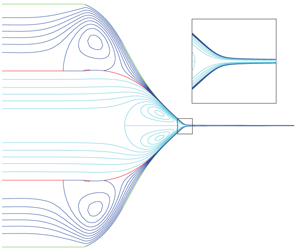Crossref Citations
This article has been cited by the following publications. This list is generated based on data provided by
Crossref.
Zhang, Yongchao
Kang, Can
Gao, Keke
and
Zhao, Hexiang
2020.
Flow and atomization characteristics of a twin-fluid nozzle with internal swirling and self-priming effects.
International Journal of Heat and Fluid Flow,
Vol. 85,
Issue. ,
p.
108632.
Montanero, J M
and
Gañán-Calvo, A M
2020.
Dripping, jetting and tip streaming.
Reports on Progress in Physics,
Vol. 83,
Issue. 9,
p.
097001.
Dastourani, H.
Jahannama, M. R.
and
Eslami-Majd, A.
2021.
Effects of surrounding pressure on cone–jet formation in electrospray process.
Microfluidics and Nanofluidics,
Vol. 25,
Issue. 2,
Narváez-Muñoz, Christian
Ryzhakov, Pavel
and
Pons-Prats, Jordi
2021.
Determination of the Operational Parameters for the Manufacturing of Spherical PVP Particles via Electrospray.
Polymers,
Vol. 13,
Issue. 4,
p.
529.
Zhou, Feng-Lei
and
Parker, Geoff J. M.
2022.
Electrospun Nanofibers.
p.
121.
López-Herrera, J.M.
Herrada, M.A.
Gamero-Castaño, M.
and
Gañán-Calvo, A.M.
2023.
Effects of geometry in the operation of coaxial electrosprays.
Journal of Aerosol Science,
Vol. 167,
Issue. ,
p.
106075.
Jamshidian, Mostafa
Mohammadi, Kaivan
Moosavi, Ali
and
Kazemzadeh Hannani, Siamak
2023.
Pulsed coaxial drop-on-demand electrohydrodynamic printing.
Physics of Fluids,
Vol. 35,
Issue. 3,
López-Herrera, J.M.
Herrada, M.A.
and
Gañán-Calvo, A.M.
2023.
Electrokinetic modelling of cone-jet electrosprays.
Journal of Fluid Mechanics,
Vol. 964,
Issue. ,
İbili, Hatice
and
Daşdemir, Mehmet
2023.
AgCl-TiO2/dendrimer-based nanoparticles for superhydrophobic and antibacterial multifunctional textiles.
The Journal of The Textile Institute,
Vol. 114,
Issue. 5,
p.
861.
Wan, H.
Liu, P.J.
Qin, F.
He, G.Q.
and
Li, W.Q.
2024.
Heat transfer enhancement of electrospray cooling with microencapsulated phase change material slurry (MPCMS): A comprehensive numerical model and experimental study.
International Journal of Heat and Mass Transfer,
Vol. 224,
Issue. ,
p.
125293.
Montanero, José María
2024.
Tip Streaming of Simple and Complex Fluids.
Vol. 137,
Issue. ,
p.
59.
Montanero, José María
2024.
Tip Streaming of Simple and Complex Fluids.
Vol. 137,
Issue. ,
p.
173.
Han, Daoru
Brawley, Guy E.
and
He, Xiaoming
2024.
Development of PIFE-PIC-ESP: Parallel Immersed Finite Element Particle-In-Cell for ElectroSpray Propulsion.
Narváez-Muñoz, Christian
Hashemi, Ali Reza
Hashemi, Mohammad Reza
Segura, Luis Javier
and
Ryzhakov, Pavel B.
2025.
Computational ElectroHydroDynamics in microsystems: A Review of Challenges and Applications.
Archives of Computational Methods in Engineering,
Vol. 32,
Issue. 1,
p.
535.
Fallahasghari, Elnaz Z.
Chronakis, Ioannis S.
and
Mendes, Ana C.
2025.
Lipophilic bioactive compounds nano-micro encapsulation via coaxial electrohydrodynamic atomization: A review.
Food Hydrocolloids for Health,
Vol. 7,
Issue. ,
p.
100202.



